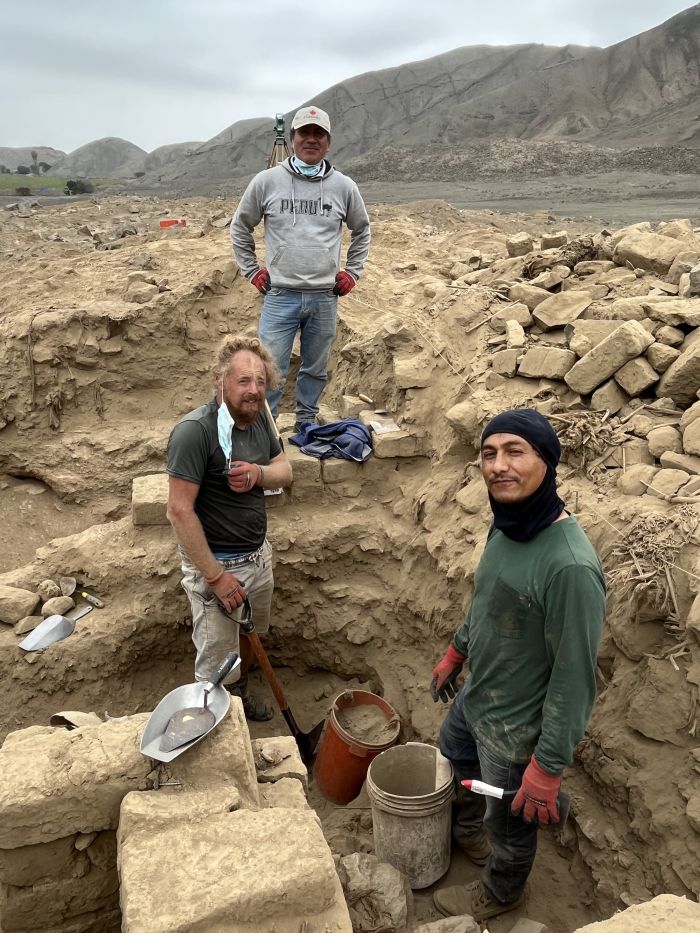
Polish and Peruvian scientists working in the Peruvian town of Barranca have discovered mummified burials of 22 people, mostly young children and newborn babies. In addition to the fabrics used to wrap the bodies, the researchers also found pottery, tools, and food remains.
The place has been known to researchers for several decades and consists of four mounds that cover pre-Columbian buildings. The time of their creation and functions remained unknown.
In 2022, archaeologists from Peru and Poland began researching the area. Its leader is Plinio Guillen Alarcón, a Peruvian archaeologist, and the Kraków bioarchaeologist Łukasz Majchrzak is the team member and co-founder. Local archaeologist Carlos Escobar also joined the "'Los valles de Barranca' team. Last year, the researchers determined that the origins of the complex dated back to the second half of the 3rd millennium BCE. At the top of the highest mound, they discovered the destroyed burials.

This year's work, during which 22 intact burials were discovered, was carried out as part of a research project financed by the Polish National Agency for Academic Exchange. The team's work is supervised by Dr. Justyna Marchewka-Długońska from the Cardinal Stefan Wyszyński University.
'The bodies are wrapped in fabrics and plant material, which in archaeology we call burial bundles. Between the layers of these fabrics we find artefacts - ceramics, tools, and cult objects', says Majchrzak, whose responsibilities in the project include the examination of human remains.
Six of the discovered burial bundles contained the remains of adults, and the remaining 16 contained the remains of children, most likely of different ages.
'Until recently, high child mortality was normal, especially when a child was weaned. This is not always reflected in the archaeological material, because children were not always buried on equal terms with adults, but often there are more of them than adults. In the case of Cerro Colorado, what we are not surprised by the number, but rather the method of making and depositing the children's bundles,’ says Majchrzak.
He adds that they are located at a similar depth as the heads of the deceased adults. ‘They are all in a horizontal position, while the adults’ bodies are in the foetal position, with their upper and lower limbs tucked under their chests. The adults' bodies are arranged vertically, as if they were sitting. They all have a similar external appearance, wrapped in thick fabric and tied with rope.
'It is difficult to give a single interpretation of this find right now. It is possible that the entire community simply buried children in this place. The puzzling fact is that these are clearly children no older than 2 years old (judging by the length of the bundles), some of them are certainly newborns or infants. It is possible that older children were buried in other parts of the cemetery for some reason,’ says Majchrzak.
So far, the researchers have only unrolled one baby bundle containing the remains of a newborn. 'We have examined two more bundles with tomography, so we know that one of the children was slightly older, and the other was also a newborn,’ Majchrzak continues.
Another of the already inspected bundles contains the remains of an approximately 15-year-old-girl who - as Majchrzak says - 'had not been a mother yet', as indicated by the lack of changes typical of women giving birth on the surface of the pubic symphysis. 'In the Andes, women married early, so even 13-14 year old girls had children. We know that she was intentionally mummified, just like the child from the second unrolled bundle,’ he says.

The fabric of one of the unrolled bundles is decorated with geometric patterns. The remaining bundles - as Majchrzak suggests - may contain depictions of animals and gods.
The materials in which the dead were wrapped were supposed to be useful in the afterlife. 'In the Andean vision of the afterlife, a person travels for a year before reaching the destination. So they need food. We found corn cobs and other unidentified plant materials in several of the bundles. However, for Andean graves, there were few vessels, 4-5 per each bundle,’ says Majchrzak.
The researchers will analyse further burial bundles, which they preliminarily date to 1000 - 1100 CE. These preliminary findings will be confirmed by radiocarbon dating.

The scientists will use computed tomography to examine completely preserved burial bundles with no visible damage. It will enable non-invasive anthropological analysis. In further stages, they plan to carry out chemical and isotopic analyses, including the strontium isotope, which will clarify whether we are dealing with a local population.
The researchers involved in the project 'The impact of extreme climate phenomena on the state of preservation of archaeological sites in Peru' include Dr. Paweł Ćwiąkała and Dr. Edyta Puniach from the AGH University of Science and Technology in Kraków, who performed photogrammetric scans of cemeteries at risk of destruction. In turn, Dr. Michał Wasilewski from the Jagiellonian University identified the areas most exposed to rapid erosion processes accompanying the ENSO weather phenomenon (its two phases are El Niño and La Niña). Students Róża Dziubińska from the Jagiellonian University and Karina Woźniak from the University of Łódź also participate in the project.
PAP - Science in Poland, Ewelina Krajczyńska-Wujec
ekr/ zan/ kap/
tr. RL













